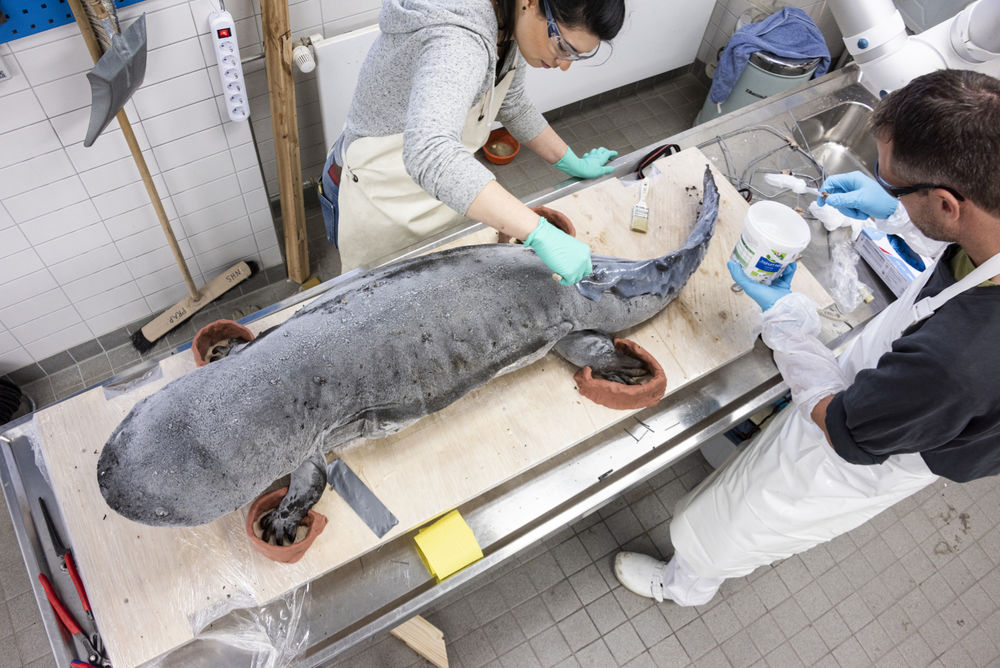Giant salamanders are the largest amphibians alive today. There are four known species, but the Chinese giant salamander is particularly remarkable for its enormous size, growing up to 180 cm in length. It is generally only in captivity that the animals reach these sizes, however; such big specimens have rarely been sighted in the wild. This is largely due to the giant salamander’s growth rate: it grows exponentially for just the first 10 years of its life, with growth – and notably, when necessary, even regeneration – continuing throughout adult life but at an increasingly slower pace. Thus, it is only very old animals that reach exceptional sizes. The fact that both Japanese and Chinese giant salamanders are considered a culinary delicacy in their regions of origin has meant that, in the past, the animals were captured in great numbers, the larger specimens being of particular interest to humans. For this reason, large individuals soon disappeared almost completely in the wild. Both the Chinese and the Japanese giant salamander are now strictly protected by law – but only after the wild populations had been reduced almost to zero.

In the wild, the animals live in the tributaries of large rivers, like the Yangtze River in China. Here they prefer secluded regions where the water quality is good, with high levels of oxygen. They live as solitary individuals and are predominantly nocturnal ambush predators. They are not particular about what they eat; lurking close to the riverbed, they snap up not only passing fish, insects, and worms but even smaller members of their own species and other amphibians. Because of their hidden nocturnal habits, not much was known about these animals at first. It was only in captivity that they began to be studied more closely.
Captive giant salamanders have been kept in aquariums and zoos for a long time, from as early as the first decades of the 19th century. It was a German doctor and naturalist, Franz von Siebold (1796–1866), who brought the first Japanese giant salamander to Europe. It was presented to the public, first at the natural-history museum in Leiden and later at Natura Artis Magistra, the royal zoo in Amsterdam. Other zoos began to be interested in these creatures that seemed to provide a living snapshot of prehistoric amphibian zoology, with the zoological gardens in Hamburg, Berlin, and Leipzig being among the first in Germany to keep them. The early 20th century saw the first successful attempts to breed them in captivity. Today, captive-bred giant salamanders contribute enormously to the preservation of both Asiatic species, since in the wild they are still prey to organized poachers willing to satisfy the unabated demand from Asian cuisine and traditional Chinese medicine.
Measuring a good 170 cm in length, the Chinese giant salamander specimen that has recently found its way into the Natural History Collections at Museum Wiesbaden comes originally from the Vivarium in Darmstadt. It arrived there via the Netherlands 58 years ago when it was about 6 years old, presumably after having been captured in the wild, and lived in a large pond at the Vivarium until its death on 23 June 2019. Its estimated age of over 60 is all the more astonishing when one considers that the ecosystem of the Vivarium pond, with its barely moving, rather murky water, hardly corresponded to the clear, oxygen-rich water of the Chinese giant salamander’s preferred habitat. With its enormous size and an estimated weight, when alive, of 60 kg, this is one of the largest Chinese giant salamanders ever recorded. It was therefore imperative that its body and skeleton be preserved. Its 170 cm length now makes it the largest preserved example of an extant amphibian species in the world.

After its death, the giant amphibian had to be refrigerated as soon as possible, pending transport to the museum, since its soft tissue was liable to rapid decomposition. Once at the museum, ‘Lurchi’ – as the new arrival had meanwhile been christened by the team – was prepared so a cast could be taken and its skeleton reconstructed. When birds and mammals are prepared for display, their skins are removed, but this was impossible with the very thin, permeable, moist skin of the giant salamander. This was why a mould was taken instead, from which a cast of the animal could be made. In order to do this, its body was carefully defrosted, arranged in a life-like position, and then re-frozen in this pose.

Next, silicon was applied to the still-frozen body, an initial mould taken, and an initial cast made from the mould. This cast was then modelled to reproduce, for example, the folds of skin and the animal’s toes, as accurately as possible. From this initial, modelled cast, a second, final mould was prepared.
Two casts of the giant salamander were taken from the final mould. One is currently being prepared by the taxidermists in the department responsible for the permanent exhibition, where, from June 2020, it will be on display in the room devoted to the theme of ‘Time’. The second cast is already in the Vivarium in Darmstadt. The special thing about these casts is the material used: a mixture of synthetic resin and 10 kg of real bronze – resulting in a cold cast in bronze.

Working as a research assistant in the Natural History Collections, it was particularly interesting for me as a herpetologist (reptile and amphibian specialist) to take a leading role in a project like this. For despite a long history of studying giant salamanders in captivity, there is still a great deal we don’t know about these animals. Over the last few years, for example, genetic studies have helped prove the existence of a new, hitherto unknown species of giant salamander, which has only recently been described as a separate species in its own right. With this imposing exhibit, the already extensive zoological collection of Museum Wiesbaden has acquired, at the very least, a unique addition, unparalleled anywhere in the world.
After all this intensive work on ‘Wiesbaden’s Lurchi’, however, one big final question remains unanswered: Lurchi’s sex. This can only be determined by an analysis of genetic material, and sample tissue has already been sent off for genetic analysis. This is why new-born giant salamanders in zoos are usually given gender-neutral names.
Dr. Lukas Hartmann
Translated by Lance Anderson